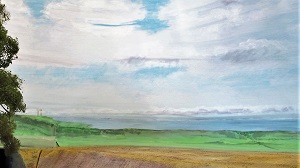After a lull in modelling during the summer, I returned to the diorama and later in the autumn started a new loco. My model in the Vale of Glamorgan is slowly acquiring a landscape in this south-easterly view, in which the trees act as an easterly view blocker. The Aberthaw power station chimneys are just visible on the Welsh side of the Bristol Channel (on the left past the lower branches), while on the English side Weston-super-Mare is lost in the haze below the distant line of low-lying clouds.
By the middle of September I was collecting information on the GWR 2884-class 2-8-0s with help coming from Devon, Lincolnshire and Yorkshire (thanks Ian, Ian and Nick). The inspiration for a model of this class was finding out that it shared a Swindon No 1 boiler with my Hall and has a similar side-window cab. I like the idea of building a pair of locos with design similarities, as with the two Caledonian 4-4-0s I made for Kyle of Sutherland.
One of the very few colour photographs I took of ex-GWR locos in steam was of 3842 at Cardiff in the spring of 1965. The model will be of 3832, the first of this class I saw in November 1962 at Worcester on a school trip to Stratford-on-Avon. A heavy freight loco for St Donats 1963 is not as illogical as it sounds: the real Vale of Glamorgan Railway regularly hosted trains diverted from the main Bridgend to Cardiff line because of engineering work.
This mock-up of 3832’s cab, footplate and smokebox saddle was paired with Toynbee Hall’s boiler to test my boiler theory against the 1965 photograph taken alongside the then-new Cardiff Canton diesel depot.














